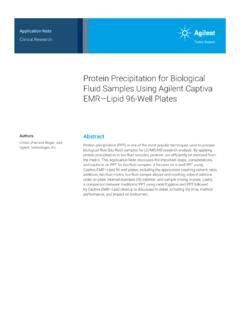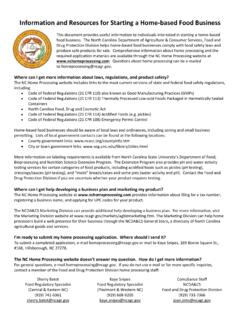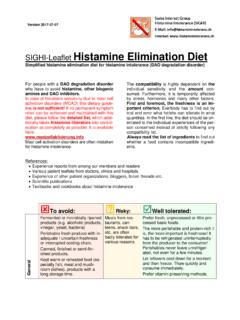Transcription of Federal and State Regulations on Selling Fermented Foods
1 Federal and State Regulations on Selling Fermented Foods Introduction1 Standards of Identity/Definitions Fermented Foods are low- acids Foods (typically fruits Sauerkraut2 The product of characteristic acid flavor, obtained by and vegetables) subjected to the full fermentation, chiefly lactic, of properly prepared and the action of acid-producing shredded cabbage in the presence of not less than 2 percent nor microorganisms to reduce the more than 3 percent of salt. It contains, upon completion of the pH of the food to or fermentation, not less than percent of acid, expressed as lactic below. Examples of acid. Sauerkraut which has been rebrined in the process of canning Fermented Foods are or repacking, contains not less than 1 percent of acid, expressed as sauerkraut, some pickles, lactic acid.
2 Kimchi, and kombucha. The Kombucha3 While there is variation among kombucha products, concern about Fermented the term kombucha generally refers to a Fermented beverage Foods is Clostridium produced from a mixture of steeped tea and sugar, combined with a botulinum. Clostridium culture of yeast strains and bacteria. The combination of sugar and botulinum is a microorganism yeast triggers fermentation, which may produce a kombucha with that produces a fatal toxin in an alcohol content of or more alcohol by volume. When this anaerobic environments with happens, the kombucha is regulated as an alcoholic beverage under a pH above The toxin Federal law and TTB Regulations . causes botulism, a serious Kimchi4 Kimchi is a Korean spicy Fermented combination of paralytic illness that can be pickled vegetables.
3 The vegetables most commonly used in its fatal and is considered a preparation are celery, cabbage, Chinese turnip, and cucumber. The medical emergency. As you vegetables are sliced, seasoned, and Fermented in brine in large may notice, the differences earthenware jars. During fermentation, which takes approximately between State Regulations are one month depending on weather conditions, the kimchi jars are rather large. Take time to stored totally or partially underground in cellars or sheds built ensure you are following the expressly for this purpose. correct laws. Be sure to also Fermented foods5 are low-acids Foods (typically fruits and look at additional resources vegetables) subjected to the action of acid-producing for more information.
4 Microorganisms to reduce the pH of the food to or below. Examples of Fermented Foods are sauerkraut, some pickles, kimchi, and kombucha. The information in this document pertains to specific types of manufacturers. Manufacturers that sell their product directly to consumers through farmers' markets, roadside stands, or other similar venues should direct their attention to the For Manufacturers Selling Directly to Consumers portion of this document. Manufacturers that do not sell directly to consumers (those that sell to restaurants, grocery stores, or other manufacturers) should view the For Manufacturers Not Selling Directly to Consumers portion of this document, directly below. For Manufacturers Not Selling Directly to Consumers Federal6.
5 All Fermented Foods producers are required to follow current Good Manufacturing Practices [21 CFR Part 117, Subpart B, and 21 CFR (Qualifications of individuals who manufacture, process, pack, or hold food .)]. Most Fermented Foods producers are required to comply with Hazard Analysis and Risk-based Preventive Controls [21 CFR Part 117, Subpart C]. Businesses which average sales in human food of less than $1,000,000 annually (adjusted for inflation) during the 3 year period before that current year sales and the market value of any food produced that was held without sale are considered very small . Fermented Foods are exempt from the hazard analysis and preventive controls requirements components in 21 CFR Part 117, Subparts C and G (and are subject to modified requirements in 21 CFR ), but are required to follow current Good Manufacturing Practices.
6 Current Good Manufacturing Practices are practices that minimize the chance of chemical (including allergens), microbial, and physical contamination of Foods . Personnel must be trained in food safety as it relates to their job duties. The plant, grounds, equipment, utensils, and processing lines must be kept in good sanitary condition. The fermentation process must be adequate to create a safe Fermented product. Fermented Foods with acid added are considered acidified Foods under 21 CFR Part 114. Operators must have a supervisor who has attended an FDA recognized training course specifically designed for canning acidified Foods . The most widely available approved course is the Better Process Control School. Anyone working on the processing and packaging side of an acidified Foods operation must be under supervision by the trained individual during all operating hours.
7 The food safety plan required by 21 CFR Part 117, Subpart C must include a written hazard analysis. This hazard analysis identifies reasonably foreseeable hazards and whether any of those hazards require preventive controls, or must justify why a hazard does not require a preventive control. If a preventive control is identified, written documentation of monitoring procedures, verification procedures, corrective actions, a recall plan, and validation information for identified process preventive control are required for each process ,8,9. 2. For Manufacturers Selling Directly to Consumers Illinois10. Fermented Foods - All Fermented Foods , including kombucha and kimchi, must be produced in a licensed kitchen. They are not able to be produced or sold as home-processed Foods .
8 Indiana11. Fermented vegetables- vegetables placed in a brine (saltwater). solution in which bacteria produce lactic acid to acidify the product and do not require refrigeration may be sold by a Home-Based Vendor. Note: Vegetables that require the addition of any acid ( , vinegar) are NOT considered Fermented . General Guidance-All Home Based Vendors Foods must have the following statement printed at a minimum type size of 10 points on product labels: This product is home produced and processed and the production area has not been inspected by the State Recipes Department of Health. The product must include a detailed label. Kimchi Iowa12. prepare-ferment/. Fermented Products Home canned fruits and vegetables as well as #.WaXo3fqGOM8. Foods prepared using a specialized process are not allowed to be sold at a farmers' market unless they are produced in a licensed Sauerkraut kitchen.
9 Preservation/news/2012/ Kansas13. sauerkraut Fermented food - Naturally Fermented canned Foods sauerkraut, kimchi, and kombucha- require a license to be sold. Kombucha Michigan14. prepare-ferment/ Fermented food No beverages, including fruit/vegetable juices #.WaXpXPqGO and kombucha tea, are allowed to be made in a home kitchen. M8 Canned fruits and vegetables or pickled products like corn relish, pickles, or sauerkraut are not allowed to be made in a home kitchen. Pickles factsheet/HYG-5342. 3. Minnesota15,16. Fermented food Fermented fruit, vegetables, pickles, sauerkraut, and kimchi that have an equilibrium pH. value of or lower and heat treated to kill vegetative cells are allowed. Fermented products needing refrigeration and kombucha are not allowed to be home-processed and sold.
10 General Guidance- Cottage food producers must do the following: 1. Register with the Minnesota Department of Agriculture (MDA) before Selling exempt food regardless of the amount of food sold. 2. Take an approved food safety course once every three years while actively Selling cottage food . 3. Register with the MDA each year food is sold under the Cottage food Exemption. 4. Prepare and sell only NON-potentially hazardous food (such as baked goods, certain jams and jellies). and/or home canned pickles, vegetables, or fruits with a pH of or lower. 5. Label food with your name and address, the date produced, and the ingredients, including potential allergens. 6. Display a sign that says These products are homemade and not subject to State inspection.








